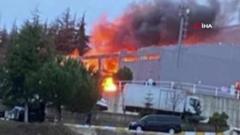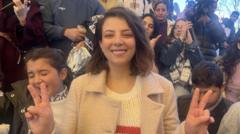**Amidst ongoing regional tensions, the emerging Syrian government aims to solidify authority by incorporating various rebel factions while navigating complex relationships with external stakeholders.**
**Syria’s New Leadership Seeks Unity Among Rebel Factions Post-Assad Regime**

**Syria’s New Leadership Seeks Unity Among Rebel Factions Post-Assad Regime**
**Recent developments indicate an effort by Syria’s new ruling coalition to consolidate power by integrating rebel groups into a single governance framework.**
Syria’s newly emergent leadership is actively pursuing the unification of various rebel factions under a centralized government in the aftermath of Bashar al-Assad’s removal from power. According to reports from Sana, the state-run news agency, a coalition of rebel groups has agreed to dissolve their individual entities to create a cohesive administrative framework.
As part of this initiative, rebel factions will be integrated into a central defense ministry, signaling a notable shift in the control dynamics within Syria. Visuals shared via social media platforms depict Ahmad al-Shara, the leader credited with the ousting of Assad, convening a meeting with numerous rebel leaders, many of whom were in military dress, in Damascus.
In a press briefing on Sunday, al-Shara emphasized the need for a strong state structure, stating, “The logic of a state is different from the logic of a revolution.” His commitment to eliminating unsanctioned weapons aligns with the intention to establish state control over military capabilities. The agreement, however, raises questions about the participation of all factions, particularly the Syrian Democratic Forces (SDF), which operates in the northeast and has longstanding partnerships with U.S. forces to combat the Islamic State group.
The SDF’s exclusion from the new accord may complicate the evolving landscape, as they grapple with advances from Turkey, which regards the Kurdish militant faction as a threat due to its associations with groups hostile to the Turkish state.
While the Syrian administration appears to be making strides in governing, lingering uncertainties about inter-rebel cooperation and the SDF's role highlight the precarious nature of these developments in a country long marred by civil strife and geopolitical rivalries.
As part of this initiative, rebel factions will be integrated into a central defense ministry, signaling a notable shift in the control dynamics within Syria. Visuals shared via social media platforms depict Ahmad al-Shara, the leader credited with the ousting of Assad, convening a meeting with numerous rebel leaders, many of whom were in military dress, in Damascus.
In a press briefing on Sunday, al-Shara emphasized the need for a strong state structure, stating, “The logic of a state is different from the logic of a revolution.” His commitment to eliminating unsanctioned weapons aligns with the intention to establish state control over military capabilities. The agreement, however, raises questions about the participation of all factions, particularly the Syrian Democratic Forces (SDF), which operates in the northeast and has longstanding partnerships with U.S. forces to combat the Islamic State group.
The SDF’s exclusion from the new accord may complicate the evolving landscape, as they grapple with advances from Turkey, which regards the Kurdish militant faction as a threat due to its associations with groups hostile to the Turkish state.
While the Syrian administration appears to be making strides in governing, lingering uncertainties about inter-rebel cooperation and the SDF's role highlight the precarious nature of these developments in a country long marred by civil strife and geopolitical rivalries.



















